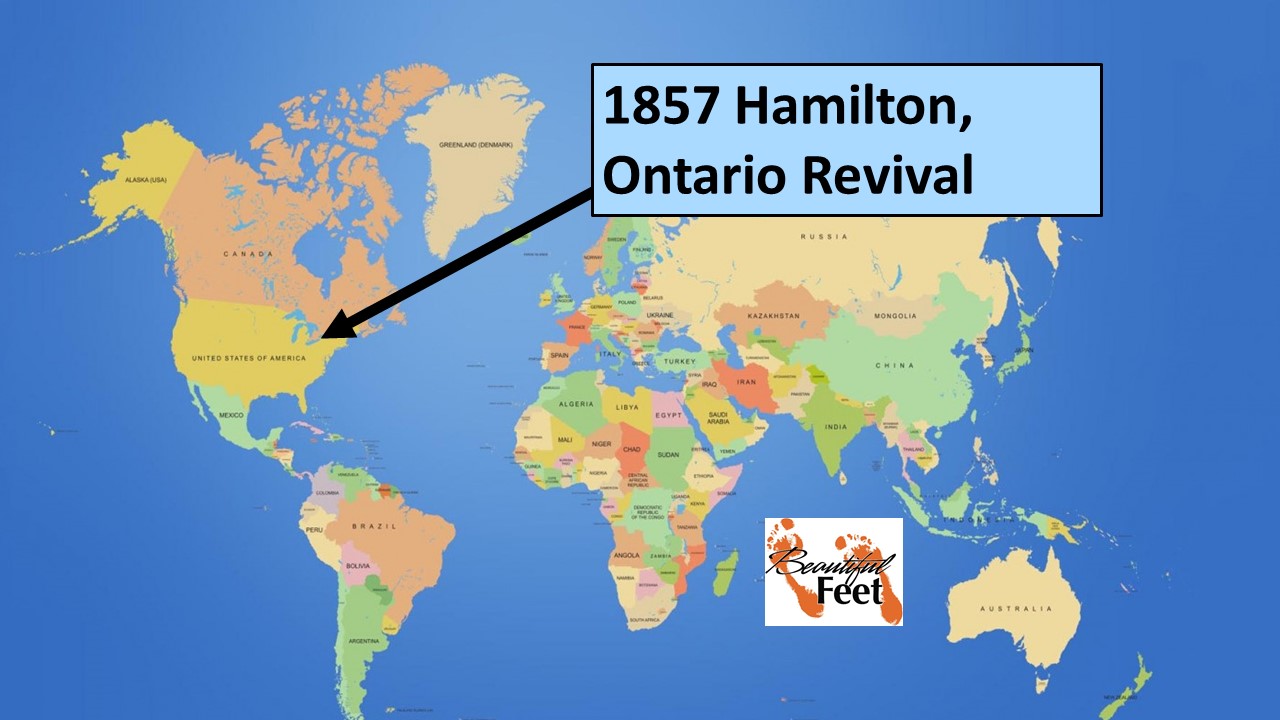
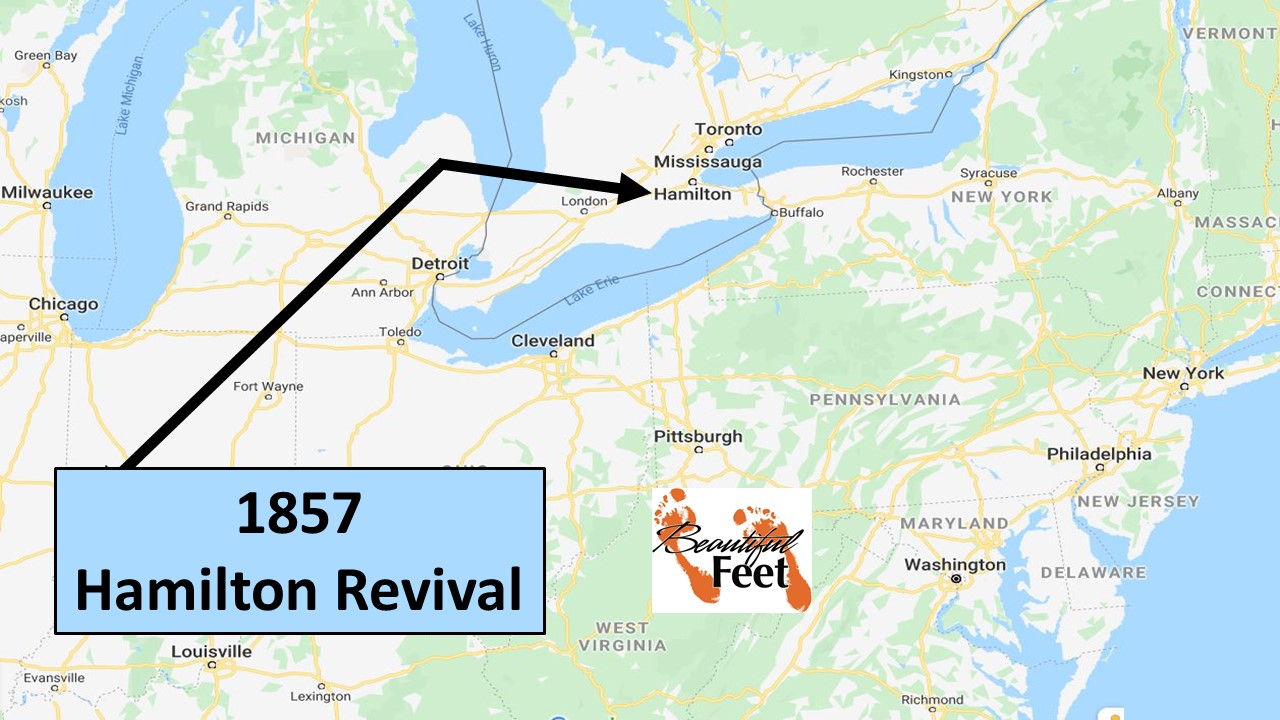
Initial Stages
In August 1853 Dr. Walter and Phoebe Palmer spoke at a camp meeting held at a farm close to Nappanee, Ontario. The result was 500 people making a profession of their faith in Christ. In 1854 the Palmers returned to Nappanee and in a letter to his daughters, Dr. Palmer wrote:
The meetings I cannot describe to you; there were hundreds converted. It was one of the most glorious meetings I ever attended.
In 1855 they held meetings in Barrie, Ontario, where again hundreds were converted.
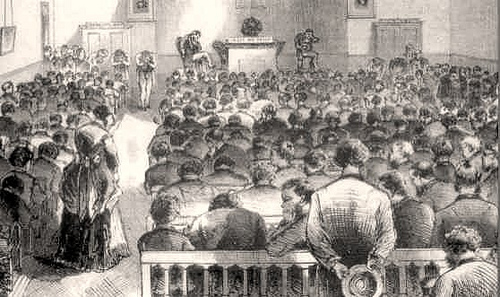
Typical prayer meeting during the era
What Happened in Hamilton, Ontario
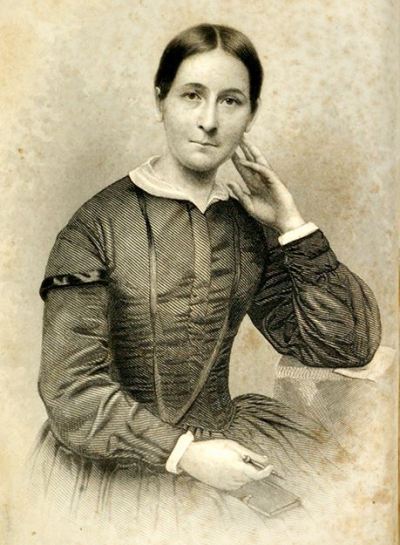
Phoebe Palmer
►In September of 1857 the Palmers conducted meetings in Georgetown, Ontario. These meetings drew crowds of 5,000 or more.
►At the conclusion of weeks of meetings, during their return to Albany, New York where they lived, their luggage was lost, and they were required to stay the night in Hamilton, Ontario.
►Their delay was longer than anticipated, and while staying with friends they met with a few Methodist ministers who requested that they conduct a prayer meeting on Thursday, October 9, 1857.
►The Palmers agreed to the request and three Methodist churches combined for this prayer meeting held at John Street Methodist Church, with about 65 people being present. During the prayer meeting a challenge was made to pray for an “outpouring of the Holy Spirit”. They were also challenged to bring their friends with them to a meeting they would conduct the following day. On Friday, after the ministry of the Word, 21 people made a profession of their faith in Christ.
►Another meeting was held on Saturday, and another 20 made a commitment to Christ. On Sunday, the number had risen to 75.
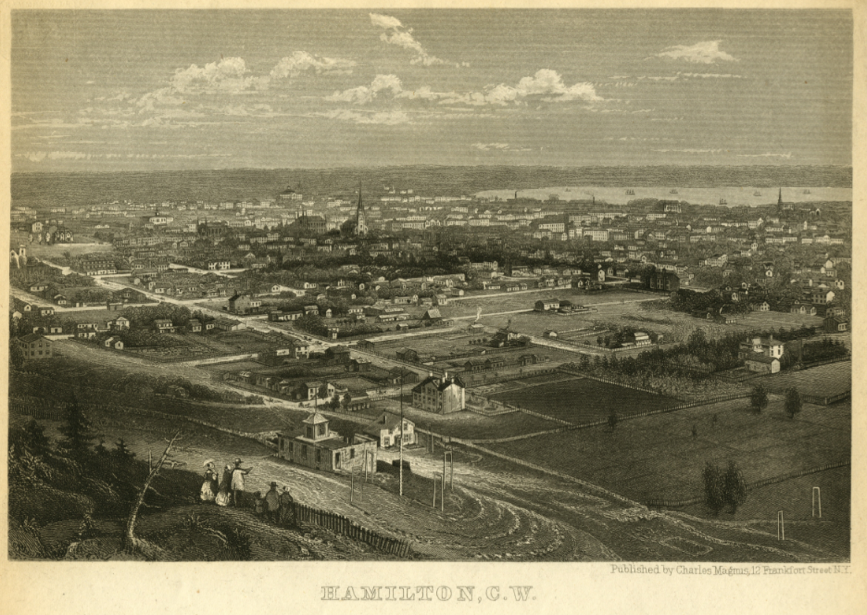 Hamilton, Ontario (1850s)
Hamilton, Ontario (1850s)
►Meetings then began to be conducted daily from 7 a.m. till 10 p.m.
►The Hamilton Revival of 1857 swept the community and a large part of Canada, and gave impetus to massive revivals in Europe and the United States. Revival historian J. Edwin Orr confirms that the first stirring of revival, that was soon to be felt globally, began in Hamilton:
For the beginnings of the religious revival which was soon to flood the United States, it is necessary to look beyond the borders of the Union. The first unusual stream of blessing arose in the city of Hamilton, in the Province of Ontario.
►Orr continued by reflecting on current news reports:
… “It was among the Ontarian Methodists that the first fruits of the 1858 revival occurred. The Methodist “Christian Advocate and Journal” of New York carried on November 5, 1857, a prominent headline “Revival Extraordinary” on its front page, with a sub-title which declared that from three to four hundred souls had been saved in a few days. Twenty-one persons had professed conversion on the first day of the movement and, as the work steadily increased, the number of professions grew to a score to forty-five daily, and a hundred people were converted on the Sunday previous to the penning of the report. The enthusiastic correspondent stated:
The work is taking within its ranges persons of all classes. Men of low degree, and men of high estate for wealth and position; old men and maidens, and even little children, are seen humbly kneeling together, pleading for grace. The mayor of the city, with other persons of like position, are not ashamed to be seen bowed at the altar of prayer beside the humble servant…
Infectious Nature of Revivals
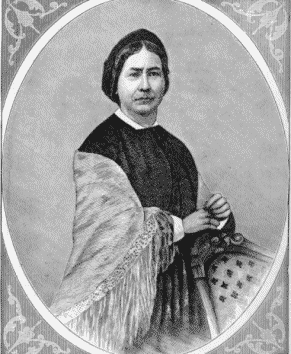
Phoebe Palmer
►The revival experienced in Hamilton began to spread wherever the news was reported. The revival historian J. Edwin Orr indicated that this one revival did not become a flowing river, but it became a “flood,” which expanded throughout the world;
Spiritual awakenings are exceedingly infectious, and proximity in time and place adds to the stimulation of desire for similar blessing. The appearance of the account [of the Hamilton revival] by a steadily increasing number of paragraphs describing local revivals, few in number in November, increasing in December, and a veritable flood in late winter and spring of 1858.
►The report was that 600 people professed faith in Christ.
►The Palmers also conducted meetings in Oswego, Binghamton, and Union, New York, as well as in locations in Connecticut. In August 1858 they were in Canada again (St. John, Halifax, Prince Edward Island). The number of conversions at these locations exceeded 1,670.
►The Palmers then visited England, Ireland, and Wales, and spent several years there conducting very successful ministry with many thousands being converted.
Results—1,000 Percent Increase
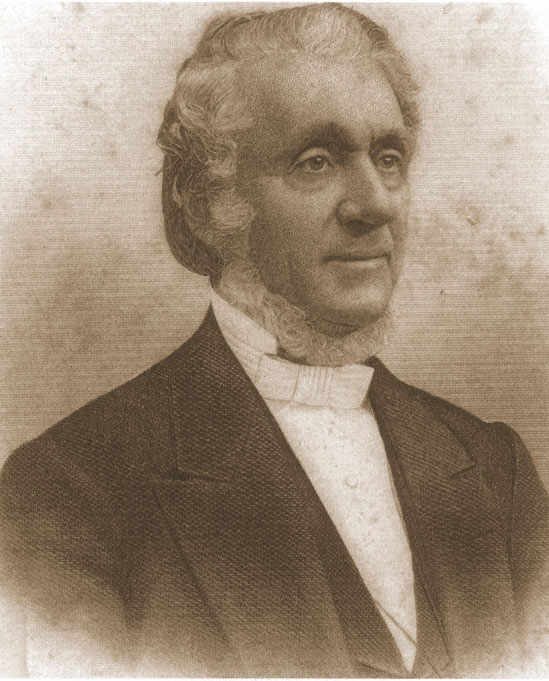
Dr. Walter C. Palmer
Husband of Phoebe Palmer
►The Methodist churches of Hamilton grew by 1,000 percent. The other churches in the town were unaffected.
►Rev. Bruce Woods of Stanley Avenue Baptist Church in Hamilton (1972-1988) wrote that not all recognized the hand of God at work until after the revival had subsided:
The Baptists and Presbyterians were largely untouched. Anglicans remained coldly aloof. Only after the divine visitation had come and gone did others awaken to the magnitude of the events that had transpired in their midst.
►Phoebe Palmer’s preaching overshadowed that of her husband’s (he being an assistant). She has been credited with being one of the founders of the Holiness Movement in the United States, and the Higher Life Movement in the United Kingdom. Her influence led to the organization of The Church of the Nazarene, The Salvation Army, The Church of God, and The Pentecostal-Holiness Church.
►Encyclopedia.com says the following of Phoebe Palmer:
Palmer became one of the most influential female religious leaders in the latter part of the nineteenth century. At a time when most evangelists were men, Palmer converted thousands of people in the United States, Canada, Great Britain, and Europe, and she did much to advance the role of women in religion.
►Christian History Institute has this to say of her:
Phoebe Palmer was the most influential woman in the largest, fastest-growing religious group in mid-19th-century America—Methodism. By her initiative, missions were begun, camp-meetings instituted, and many thousands attested to the transforming power of divine grace. She mothered a nationwide movement that birthed such denominations as the Church of the Nazarene and the Salvation Army, bridged 18th-century Methodist revivalism to 20th-century Pentecostalism, and pioneered in social reform and female ministry.
Sources
- Phoebe Palmer by encyclopedia.com
- Phoebe Palmer by the Christian History Institute
- Phoebe Palmer by Wikipedia
- Phoebe Palmer Mother of the Holiness Movement by Christianity Today
- Renewal Journal by Geoff Waugh
- Revivals in North America: The Hamilton, Ontario, Canada Revival of 1857 by Gerald Procee
- The Day When Hamilton Changed the World by Daina Doucet
- The Event of the Century by J. Edwin Orr
- The Second Evangelical Awakening in America by J. Edwin Orr
Return to List of Revival Stories
Chet & Phyllis Swearingen:
Office: (260) 920-8248
romans1015@outlook.com
Beautiful Feet
P.O. Box 915
Auburn, IN 46706

